Created by A. "Miru" Lee (INKtrashing)
"A character design project I’ve been mulling over for a while. I wanted to try taking some staple fantasy-based classes and see how they’d translate to a apocalypse-based setting, something vaguely Mad Max- or Fallout-flavored. Also squeezing in some practice working with weapons and clothes. :)
The priest class was one of the first classes I wanted to try redesigning. Of course, they’d have to have strong parallels to field medics, but I also specifically wanted them to look a bit like surgeons. The main components of their outfits are ruined doctor’s coats and surgical garments in that signature bright teal (bandannas, masks and gloves).
Dart guns take the place of priest-ly magic, used for healing (“medi-darts” ala Fallout’s stimpaks), buffs (painkillers, adrenaline shots) and de-buffs (tranquilizers). They use blasts of pressurized air instead of any gunpowder, and are reloaded with aircans; the darts come slotted onto “cartridges” of semi-flexible metal strips, which are ejected and reused.
Like most healers, these guys aren’t very good offensive units, but they do carry bonesaws as last resorts for self-defense."
"A slightly more straightforward translation from fantasy to a semi-realistic setting. The main focus became finding modern parallels for armor. Knights are well-rounded classes, so I wanted their equipment to be robust, but easy to move in; sports gear ended up being the best replacement.
Their outfits are mostly composed of motocross equipment (jersey, pants and boots in attractively garish color schemes), with additional sports gear stacked on top — MMA headgear, football/baseball protective gear, ice hockey gloves, lacrosse shinguards. The swords are rather crudely bolted and cobbled together from scrap metal; foraged riot gear can also be used in place of a second sword."
"Hunters (or archers/rangers) were one of the two classes I had the most trouble reworking. I considered making them ‘snipers’ before deciding that it would be more cohesive if none of the classes used actual guns. So these guys ended up being designed with (hypothetical) PvP vs. PvE configurations in mind.
The general focus for both of them is stealth.
PvP equipment (left) is designed for a ruined urban setting, balancing stealth, protection and high mobility. Loose hoodie sleeves are taped close to the body for ease of movement, the night vision goggles help in dark areas, and basic protective gear (archery chest guard, thigh- and shin-guards) raise defense. The crossbow helps punch through armor.
PvE equipment (right) sacrifices some mobility and defense in exchange for even higher stealth. The ghillie suit base allows for adaptation to different types of foliage, and the compound bow — while less punchy than the crossbow — keeps the noise level down and allows for quicker “reloads”."
"Merchants are a rather strange class to consider for a game, but they seem like an indispensable part of the fantasy class landscape in a way.
Merchants, of course, would have to have a way to carting around their goods; for a post-apocalyptic setting, I think the huge packs usually used in cross-country backpacking would be a good fit. The weight of those packs means merchants can’t spare that much extra stamina to wear heavy armor, so they mostly wear normal, durable clothes and hiking shoes for ease of movement.
Being in charge of foraging for and hauling around supplies means access to some weapons that would be impractical for other classes. Molotov cocktails require more preparation time before use, but are good for quick bursts of damage. The alternative is a “junk gun.”
The junk gun works a lot like a handheld catapult, launching nuts and bolts at very high velocities, enough to feel punchy even through basic armor. It’s effectively a very crude shotgun — not terribly accurate, but enough to do the job.
Merchants obviously aren’t going to be out there doing a lot of damage, mostly acting as support, but they just have the means to hold their own when necessary."
"Given the somewhat whimsical nature of the original class, I struggled with translating bards into something more realistic before my friend Fal suggested going in the direction of rally leaders, which ended up working out great. (They started out as more straightforward rock starlets, which would have been adequate but not very unique, I think.)
The core imagery was taken from girls’ cheerleader uniforms and — due to the aggressive un-cuteness of most male cheerleadering uniforms — stereotypical ouendan clothes. I wanted both outfits to be moderately fanservice-y but easy to move in and somewhat durable.
Bards are heavily skewed towards long-distance support, so their defensive gear is a bit more for looks than functionality. They wear lacrosse leg guards and thigh guards, while their arm braces are a stacked combination of bite sleeves, police arm guards and heavy-duty gloves. MMA chestplates are optional.
Buffs and debuffs are cast by shouting cheers/chants and rallying cries through a megaphone. A portable speaker cobbled together with a backpacking strap set can be appended to the megaphone in order to increase range and effectiveness. Cheer flags serve the same function as megaphones, but can’t be enhanced with speakers; in exchange, they can be wielded like bo staffs for close- to mid-range combat."
"Rogues were the class other than archers that gave me the most trouble in redesigning. In the end, I decided it would be easiest to approach the two as DPS classes that focused on opposite aspects: stealth vs. speed. (DEX vs AGI in RPG terms?)
Rogues focus entirely on getting close to the enemy and dealing as much damage as quickly as possible. Though they wear some basic armor (dirtbike chest and shoulder protectors), their outfits mostly emphasis sleekness and mobility; speed-cycling and mountain biking clothes have a good balance of durability and ease of movement. Running shoes are favored over boots, sometimes preemptively paired with ankle braces.
Katars are the favored weapon of choice due to their huge thrusting power, much more effective at punching through armor than conventional knives and blades."
"Traditional fantasy-based “monk”-type classes seem to usually have deep ties to nature to augment their bare-knuckle fisticuffs, so I thought it’d be reasonable to take them in the opposite direction for a post-apocalyptic setting. So, these guys still rely solely on their fists in combat, but are aided by mechanical enhancements.
The mechanical enhancements are most obviously visible as large gauntlets, but also includes components integrated more deeply into the user’s physique, allowing for greater durability and strength. As a result, monks are able to “heal” (i.e. repair) themselves to a greater degree than most other classes are capable of (with the exception of dedicated healer classes).
Due to their mechanical enhancements, monks are well-rounded fighters hampered only by below-average speed and range. Though largely self-sufficient, they also don’t have any particular stand-out strengths."
"The dedicated tanks and powerhouse meatshields. Paladins are pretty much the only class clad in proper armor (scavenged riot and police armor), unlike many other classes, where their armor is cobbled together from sporting equipment and other substitutes. As a result, they tend to be incredibly robust and are able to soak up huge amounts of damage.
On the other hand, the scarcity of shields forces paladins to scrounge up some pretty creative substitutes. Because true firearms are so rare, objects like car doors, thick metal sheeting, and steel doors can be fitted with makeshift harnesses and handles to serve as shields. While these shields would be easily punctured by bullets, they aren’t so easily overwhelmed by bladed weapons or makeshift guns, making them suitable for the setting.
Heavier two-handed shields can be used as weapons themselves, functioning like battering rams in order to damage foes; they tend to have higher defense, but their attacks are much slower and clumsier. Lighter shields only require one arm to use but don’t soak up as much damage; in exchange, they can be used in conjunction with polearms like spears to deftly fend off attackers."
"Mages were the actually the first class I thought of when I started planning this series, so I thought they’d be a nice note to end on. A lot of this series started because I wanted to see if I could give “mages” an analog equivalent to magic; I also really wanted to give them some sort of long, staff-like weapon. Flamethrowers and flamethrower-equivalents ended up being the post-apocalyptic stand-in for magic: ice magic (left) is represented with a fire-extinguisher-like blaster that uses liquid nitrogen, lightning magic (right) uses a long-reach shock-prod powered by industrial- or car-batteries, and fire magic (not pictured) uses propane. Mages carry around large tanks of fuel for their respective “magic” jury-rigged together with hiking backpack straps for easy transport.
The weight of these packs means that mages can’t spare the stamina to also wear heavy armor while maintaining the level of dexterity necessary for operating their weapons. Their safety suits (usually scavenged hazmat or industrial safety jumpsuits) are light and easy to move in, but only provide basic defense, resulting in their relative frailty.
Mages are also capable of cobbling together grenade-like weapons of the same type as their main weapon. While these weapons allow for immediate bursts of damage, mages need to prepare them beforehand and can only carry a limited number of them at a time."

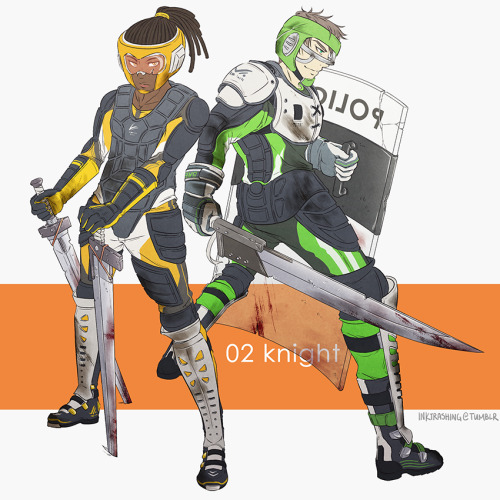
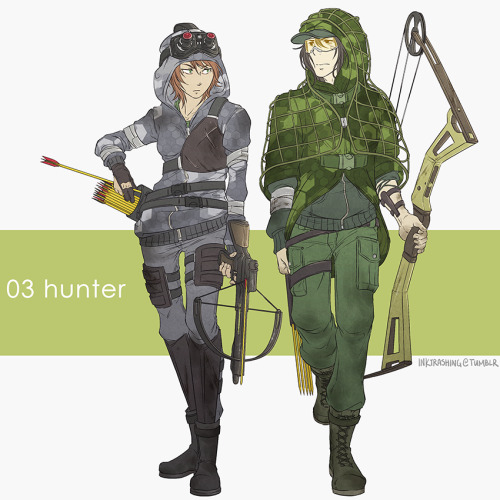
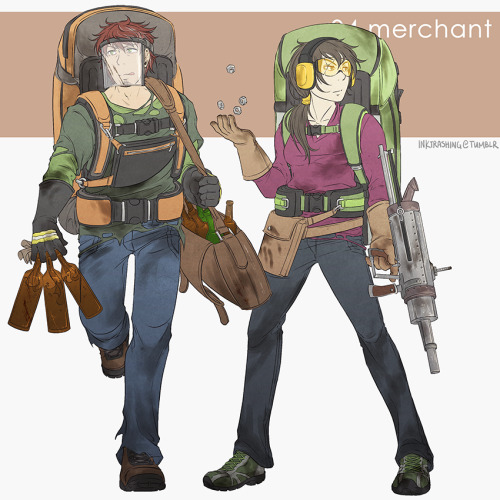
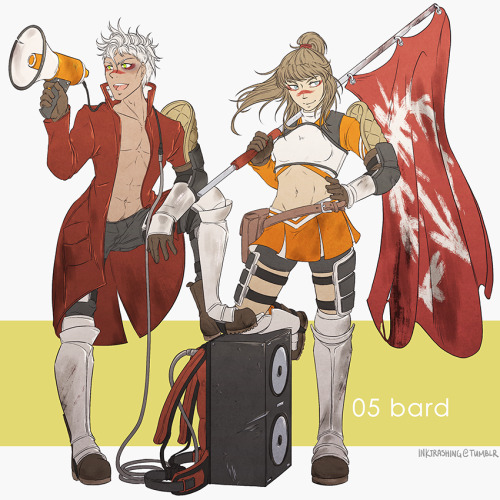
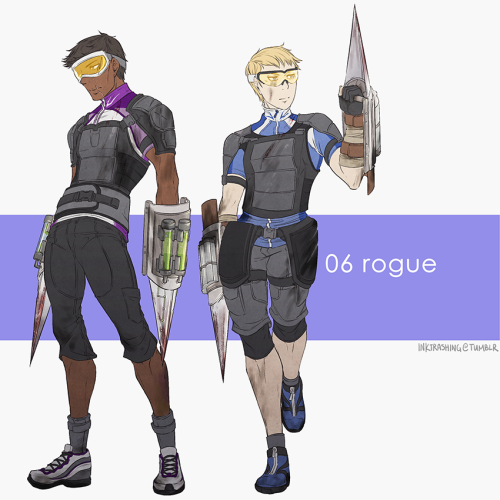
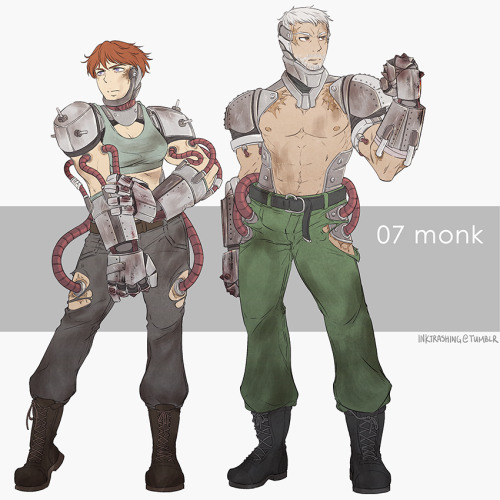
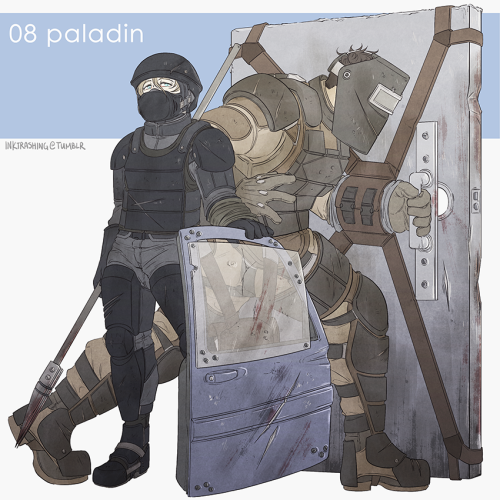
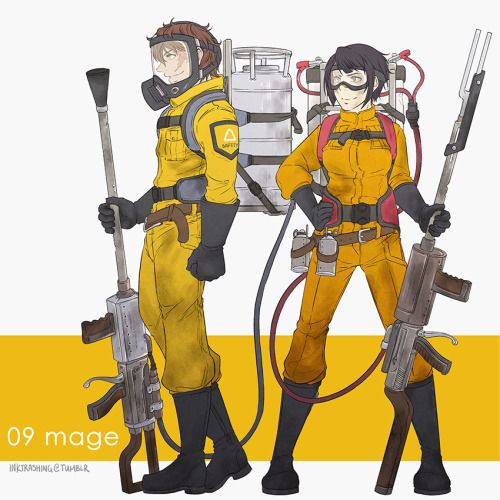
No comments:
Post a Comment